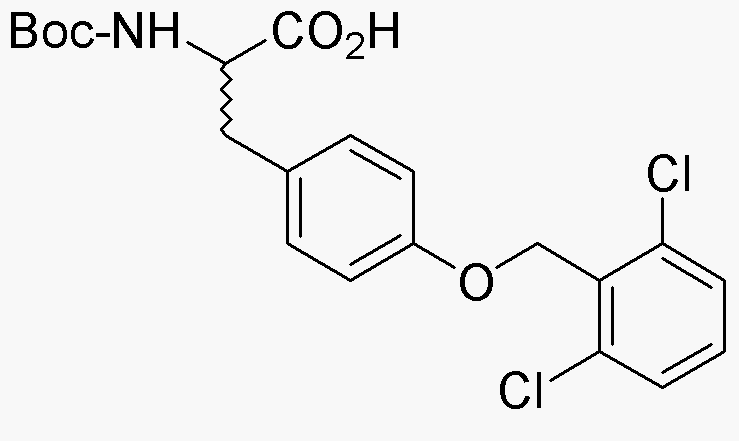Boc-O-2,6-dichlorobenzyl-DL-tyrosine is widely utilized in research focused on:
- Peptide Synthesis: This compound serves as a key building block in the synthesis of peptides, particularly in the development of therapeutic agents targeting various diseases.
- Drug Development: Its unique structure allows for modifications that can enhance the efficacy and selectivity of new drug candidates, making it valuable in pharmaceutical research.
- Bioconjugation: The compound can be used in bioconjugation processes, linking biomolecules to drugs or imaging agents, which is essential in targeted therapy and diagnostics.
- Research on Neurotransmitters: Due to its structural similarity to tyrosine, it is useful in studies related to neurotransmitter synthesis and function, aiding in the understanding of neurological disorders.
- Material Science: The compound finds applications in the development of novel materials, particularly in creating polymers with specific properties for use in various industrial applications.
General Information
Properties
Safety and Regulations
Applications
Boc-O-2,6-dichlorobenzyl-DL-tyrosine is widely utilized in research focused on:
- Peptide Synthesis: This compound serves as a key building block in the synthesis of peptides, particularly in the development of therapeutic agents targeting various diseases.
- Drug Development: Its unique structure allows for modifications that can enhance the efficacy and selectivity of new drug candidates, making it valuable in pharmaceutical research.
- Bioconjugation: The compound can be used in bioconjugation processes, linking biomolecules to drugs or imaging agents, which is essential in targeted therapy and diagnostics.
- Research on Neurotransmitters: Due to its structural similarity to tyrosine, it is useful in studies related to neurotransmitter synthesis and function, aiding in the understanding of neurological disorders.
- Material Science: The compound finds applications in the development of novel materials, particularly in creating polymers with specific properties for use in various industrial applications.
Documents
Safety Data Sheets (SDS)
The SDS provides comprehensive safety information on handling, storage, and disposal of the product.
Product Specification (PS)
The PS provides a comprehensive breakdown of the product’s properties, including chemical composition, physical state, purity, and storage requirements. It also details acceptable quality ranges and the product's intended applications.
Certificates of Analysis (COA)
Search for Certificates of Analysis (COA) by entering the products Lot Number. Lot and Batch Numbers can be found on a product’s label following the words ‘Lot’ or ‘Batch’.
Numéro de catalogue
Numéro de lot/série
Certificates Of Origin (COO)
This COO confirms the country where the product was manufactured, and also details the materials and components used in it and whether it is derived from natural, synthetic, or other specific sources. This certificate may be required for customs, trade, and regulatory compliance.
Numéro de catalogue
Numéro de lot/série
Safety Data Sheets (SDS)
The SDS provides comprehensive safety information on handling, storage, and disposal of the product.
DownloadProduct Specification (PS)
The PS provides a comprehensive breakdown of the product’s properties, including chemical composition, physical state, purity, and storage requirements. It also details acceptable quality ranges and the product's intended applications.
DownloadCertificates of Analysis (COA)
Search for Certificates of Analysis (COA) by entering the products Lot Number. Lot and Batch Numbers can be found on a product’s label following the words ‘Lot’ or ‘Batch’.
Numéro de catalogue
Numéro de lot/série
Certificates Of Origin (COO)
This COO confirms the country where the product was manufactured, and also details the materials and components used in it and whether it is derived from natural, synthetic, or other specific sources. This certificate may be required for customs, trade, and regulatory compliance.


